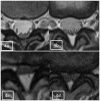MRI parameters predict central lumbar spinal stenosis combined with redundant nerve roots: a prospective MRI study
- PMID: 38859971
- PMCID: PMC11163106
- DOI: 10.3389/fneur.2024.1385770
MRI parameters predict central lumbar spinal stenosis combined with redundant nerve roots: a prospective MRI study
Abstract
Background: To observe changes in the cauda equina nerve on lumbar MRI in patients with central lumbar spinal stenosis (LSS).
Methods: 878 patients diagnosed with LSS by clinical and MRI were divided into the redundant group (204 patients) and the nonredundant group (674 patients) according to the presence or absence of redundant nerve roots (RNRs). The anteroposterior diameter of the spinal canal (APDS) and the presence of multiple level stenosis, disc herniation, thickening of ligamentum flavum (LF) and increased epidural fat were assessed on MRI. Univariate and multivariate logistic regression analyses were performed to explore the predictors of LSS combined with RNRs.
Results: Patients with LSS combined with RNRs had thicker epidural fat, smaller APDS and more combined multifaceted stenosis. Female patients and older LSS patients were more likely to develop RNRs; there was no difference between two groups in terms of disc herniation (p > 0. 05). Age, APDS, multiple level stenosis, and increased epidural fat were significantly correlated with the formation of LSS combined with RNRs (p < 0.05).
Conclusion: A smaller APDS and the presence of multiple level stenosis, thickening of LF, and increased epidural fat may be manifestations of anatomical differences in patients with LSS combined with RNRs. Age, APDS, multiple level stenosis, and increased epidural fat play important roles. The lumbar spine was measured and its anatomy was observed using multiple methods, and cauda equina changes were assessed to identify the best anatomical predictors and provide new therapeutic strategies for the management of LSS combined with RNRs.
Keywords: epidural fat; lumbar spinal stenosis (LSS); magnetic resonance imaging (MRI); redundant nerve roots (RNRs); risk factors.
Copyright © 2024 Qian, Liang, Luo and Ying.
Conflict of interest statement
The authors declare that the research was conducted in the absence of any commercial or financial relationships that could be construed as a potential conflict of interest.
Figures










Similar articles
-
Magnetic resonance imaging findings of redundant nerve roots of the cauda equina.World J Radiol. 2021 Jan 28;13(1):29-39. doi: 10.4329/wjr.v13.i1.29. World J Radiol. 2021. PMID: 33574992 Free PMC article.
-
[Study on related influencing factors on the occurrence of redundant sign in the cauda equina in lumbar spinal stenosis].Zhongguo Gu Shang. 2024 Aug 25;37(8):824-7. doi: 10.12200/j.issn.1003-0034.20201408. Zhongguo Gu Shang. 2024. PMID: 39183009 Chinese.
-
Radiological significance of ligamentum flavum hypertrophy in the occurrence of redundant nerve roots of central lumbar spinal stenosis.J Korean Neurosurg Soc. 2012 Sep;52(3):215-20. doi: 10.3340/jkns.2012.52.3.215. Epub 2012 Sep 30. J Korean Neurosurg Soc. 2012. PMID: 23115664 Free PMC article.
-
Clinical significance of redundant nerve roots in patients with lumbar spinal stenosis undergoing oblique lumbar interbody fusion combined with percutaneous internal fixation.J Orthop Surg Res. 2023 Dec 13;18(1):958. doi: 10.1186/s13018-023-04449-2. J Orthop Surg Res. 2023. PMID: 38087350 Free PMC article.
-
The clinical significance of redundant nerve roots of the cauda equina in lumbar spinal stenosis patients: A systematic literature review and meta-analysis.Clin Neurol Neurosurg. 2018 Nov;174:40-47. doi: 10.1016/j.clineuro.2018.09.001. Epub 2018 Sep 4. Clin Neurol Neurosurg. 2018. PMID: 30205275
References
-
- Papavero L, Ali N, Schawjinski K, Holtdirk A, Maas R, Ebert S. The prevalence of redundant nerve roots in standing positional MRI decreases by half in supine and almost to zero in flexed seated position: a retrospective cross-sectional cohort study. Neuroradiology. (2022) 64:2191–201. doi: 10.1007/s00234-022-03047-z, PMID: - DOI - PMC - PubMed
LinkOut - more resources
Full Text Sources

